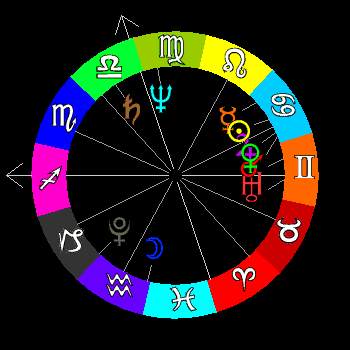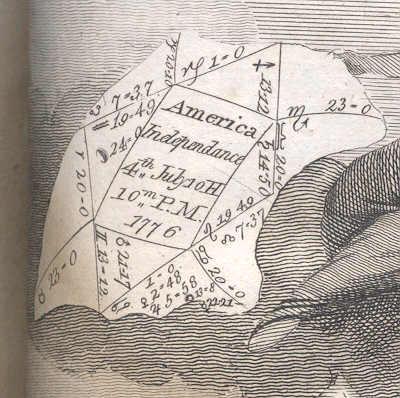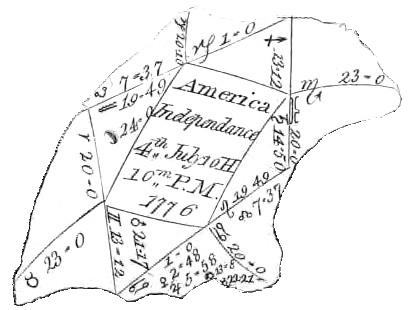
USA Horoscope:
4th July 1776 5.10pm? Philadelphia, PA (Inferred from Sibly's stated time of 10H 10m P.M.)

Sibly's Original Illustration

Image courtesy of Norm Winski from Astro-Trend
This image shows a detail from a larger illustration on page 1054 (1826 edition) from the book: A New and Complete Illustration of the celestial science of Astrology[1] written by Ebenezer Sibly. It was divided into four volumes. Part III is largely about mundane astrology and astro-meteorology and includes an analysis of the chart entitled America Independance.(sic)
Illustrated Chart does not represent a real time
Sibly's illustrated chart states 4th July 10H 10m 1776. Using modern methods of mundane astrology, it would be natural to assume that this chart was set for 22:10 in Philadelphia, Pennsylvania - the location of the signing of the Declaration of Independence and at the time the capital of the newly allied 13 colonies. However, this does not match the chart data. At that time (10:10pm) in Philly, the Ascendant (6°49') and the Moon (0°) were in Pisces and not in Aquarius as shown on the illustration. In fact, it is impossible to convert Sibly's chart wheel into real time. This table shows when the planets and angles reached the degrees and minutes specified in the illustrated chart.
| Sibly's Chart Data converted into Local Time in Britain & the USA |
| Planet/Angle |
Position |
London Time (~UT) |
Philadelphia Time (~EST) |
| Ascendant |
19°43' ♒ |
21:53 |
16:53 |
| Midheaven |
13°12'♌ |
21:53 |
16:53 |
| Sun |
13°08' ♋ |
17:24 |
12:34 |
| Moon |
24°0?' ♒ |
16:54-17:10 |
11:54-12:10 |
| Mercury |
22°21'R ♋ |
8th July |
7th July |
| Venus |
2°48' ♋ |
16:24 |
11:24 |
| Note: Times are all approximations of Local Time. Time Zones such as GMT and EST (5 hours behind GMT) did not exist and are used here to clarify the differences. |
What can be deduced from analysing the calculations?
- Imprecise Calculations: The inconsistency with his calculations partly reflects the limited knowledge of the orbital elements in the late 18th century. Though, huge advances in precision came with Isaac Newton, the orbit of Mercury, for example, was not well formulated and has been improved by discoveries such as Einstein's General Relativity in 20th century. So this may account why the position Mercury is four days out (8th July GMT).
- Longitude and Local Mean Time: Was Sibley converting longitude into local time? London is east in the GMT time zone at around 00°08'W and Philadelphia is also east on the time zone at 75°17'W - so the difference (75°09' of longitude) in strict local time between the cities is 5 hours 0 minutes and 36 seconds. So even if Sibly had calculated using only longitude data (and disregarded clock time) as was possible at the time[2], the five hour time difference (which still exists today) would have applied.
- The Angles: The Ascendant and MC are consistent. The angular data was presumably derived from the same astronomical tables. In London, the stated celestial degrees crossed the angles 17 minutes before Sibly's stated time of 22:10. I would take this as a minor error of 8°27' - the Ascendant is still Aquarius though on the correct chart the Moon just slips from the 1st into the 12th house. Neverthless, the AC/MC angle of separation could only happen on this date at around the latitude of 51°30 North and not Philadelphia at around 40° North. In addition, the closeness of the data to the time strongly indicates that Sibly was working on a London based chart.
- The Planets: Taking an average of the times for the Sun, Moon and Venus, we arrive at exactly 17:00 GMT - which happens to be noon in Philadelphia. Did Sibly use midday in Philadelphia because he had some inside knowledge that something occurred at noon or because the time was unknown and midday minimises any inaccuracy to within 12 hours? Given the range of Sibly's inconsistency (70 minutes between the Sun and Venus), I think that this coincidence of the mean time and noon is not significant. A more likely explanation is that Sibly did not know or simply forgot to add five hours when calculating the zodiacal position of each planet and used 17:10 GMT instead of 17:10 EST. This is an easy mistake especially if you are unfamiliar with the concept of different time zones - as most people would have been in the 18th century where there was no equivalent experience to jet lag. So Sibly would have had to interpolate the planetary positions from an ephemeris which was likely to have listed no more than one position per day (at midnight or midday).
- Other Explanations: There are several other possible ways of accounting for the chart. Was Sibly trying some unknown technique of merging the two charts? Did he intend to calculate the angles for 22:10 for Philadelphia but ended up with the angles for London and then made errors in the opposite direction to the planets? There is not enough evidence to rate either of these possibilities.
So on balance, there are few certainties about Dr Sibly's chart resulting in a range of possible inauguration chart times. The most plausible explanation is that he attempted to calculate the Ascendant and MC for a time (22:10) in London that coincided with the time of the signing 17:10 in Philadelphia. However, he failed to convert the US clock time to London time when calculating the planets.
|
 |
17:10 July, 4, 1776 Philadelphia? The Horoscope (displayed) set for 5:10pm for the Declaration of Independence of the United States of America is widely considered to reflect the one first proposed by Ebenezer Sibly in 1787. However, this is not the chart that Sibly published, but a deduction from his confused calculations of what he intended to do. Even when you attempt to replicate his Sag Rising chart, you might want to compare it with the rival Virgo, Libra and Gemini Rising Charts for the United States.
Ebenezer Sibly (1751-1799)
 While the date of the signing of the document is hotly disputed by historians[3], astrologers disagree about the time of signature. The most authoritative published source on the second topic is The Book of World Horoscopes by Dr Nicholas Campion.
While the date of the signing of the document is hotly disputed by historians[3], astrologers disagree about the time of signature. The most authoritative published source on the second topic is The Book of World Horoscopes by Dr Nicholas Campion.
Arguably the most widely favoured US chart with Sagittarius Rising claims its provenance from an 18th century English astrologer, Dr Ebenezer Sibly (b. Bristol 1751 - d.1799?).[4] He was also an author, physician and a herbalist. Sibly (incorrectly spelt Sibley by astrologer, Dane Rudhyar) was alive at the time of the signing and may have had access to witnesses and records that are not available today. Historian Michael Baigent has presented a case that as a Freemason, Sibly had connections with fellow masons and signatories: Hancock, Washington and Franklin.[5]
Why would Sibly (aka Sibley) set his US horoscope to London?
 Though no location is set on the illustration, an analysis of his calculations suggests that the most likely explanation is that Sibly tried to create a chart for the American Independence chart using a chart based on London. Why might he do this? Though no location is set on the illustration, an analysis of his calculations suggests that the most likely explanation is that Sibly tried to create a chart for the American Independence chart using a chart based on London. Why might he do this?
- Sibly was an English astrologer writing for his local British audience and was unlikely to be concerned with any potential colonial readership. The declaration was to Sibly, at that time, another event in British history and without sovereign assent, no more than a proclamation. He could not have envisaged the subsequent huge significance of the event as the birth of a nation that has become a super-power.
- In his book (page 1049) a few pages before the illustration, Sibley sets out how he calculates charts:
"The scheme being erected for the meridian of London, of course its application applies most nearly to the affairs of this country, but in a secondary degree to our natural enemies and allies, and to the general affairs of the northern hemisphere. For, if great exactness be wished in any particular calculation, the scheme must in all such cases, be erected for the precise latitude of the place or province to which the calculation more immediately appertains; and where any struggle exists, or event is foreboded, between any two particular states or empires, the safest way is to erect a scheme for the meridian of each, and to examine them by the same rules as have been laid down before comparing a revolutional figure with the radix of a nativity." ~ Sibly [1] Since there is only one chart, Sibly may not have sought the 'great exactness' of calculation by the addition of Philadelphia chart.
- A strange but plausible reason is that Sibly calculated a London chart because he could! Or because he could not calculate the chart for Philadelphia. Nowadays when a chart can be calculated in seconds on the click of a mouse, this seems far fetched. However, calculating charts with only a quill and ink can easily go astray. I know - I starting calculating charts by hand in the late 70s. The risk of error rises dramatically when you must make adjustments for a distant latitudes and longitudes[2] (time zones) and must work from tables published for London and possibly Liverpool or Paris.
There are various reliable (and unreliable) sources including Thomas Jefferson, that appear to corroborate a late afternoon/early evening signature on 4th July 1776. The closest to Sibly's data is an American astrologer, John B Early, who allegedly, wrote in his 1776 ephemeris or almanack in the margin for July, "Declaration signed 10.10pm" which as per Sibly, can be (loosely as there was no time zone) converted to 5.10pm LMT in Philadelphia.[6] For a full commentary on these and other rival horoscopes to the US birth - see my article entitled Astrological Birth Chart for the United States of America.
References:
- Sibly, EbenezerThe New and Complete Illustration of the Celestial Science of Astrology was also reprinted posthumously under the title Astrology, A New and Complete Illustration of the Occult Sciences (1806) The extended title of the book is The Art of Foretelling Future Events and Contingencies by the Aspects, Positions and Influences of the Heavenly Bodies founded on Natural Philosophy, Scripture, Reason and Mathematics.
- Longitude measurement was improved by the marine chronometers of John Harrison (1693-1776). Latitude was more easily recorded in the northern hemisphere by measuring the angle of the pole star (polaris) to the northern horizon.
Longitude clock comes alive
- Hazelton, John Hampden (1906) Declaration Of Independence. Its History, pp.299–302; Burnett, Continental Congress, 192. de Capo Press, NY (see)
- Curry, Patrick. Oxford Dictionary of National Biography (online ed.). Oxford University Press.
- Baigent, Michael (1983) Ebenezer Sibley and the Signing of the Declaration of Independence. Astrological Journal. Vol.XXVI #1. Winter 1983-4.
- Timson, D. (1964-5) Ebenezer Sibly, Freemason Extraordinary. Transcriptions of Lodge Research, #2249, p.62f Leicester.
- Ward, Eric (1958) Ebenezer Sibly - a Man of Parts. Transactions of the Quattuor Coronati Lodge- Vol.71, #2076, p.481, London.
- Early, John B Though this story circulates the web, I cannot find a reliable source to corroborate it. One source claims it was written in a contempary edition of Raphael's Ephemeris. However, Foulsham the publisher proudly claim that Raphael's has been published since 1819 - 43 years after the Declaration of Independence
Other Sources
- Campion, Nick (1988) "Book of World Horoscopes", 1st published 1988, ISBN 0-85030-527-6
- Greene, Liz "The Outer Planets & Their Cycles: The Astrology of the Collective", CRCS Publications (1983) p.112-114
- Rudyhar, Dane "The Riddle of the USA horoscope" July 1971 [see]
- AstroDataBank, USA No1
- Spencer, Neil (2000) "True as the Stars Above", Victor Gollancz ISBN 0752843826
Robert Currey, 22 Jan. 2013
|
|



 While the date of the signing of the document is hotly disputed by historians
While the date of the signing of the document is hotly disputed by historians Though no location is set on the illustration, an analysis of his calculations suggests that the most likely explanation is that Sibly tried to create a chart for the American Independence chart using a chart based on London. Why might he do this?
Though no location is set on the illustration, an analysis of his calculations suggests that the most likely explanation is that Sibly tried to create a chart for the American Independence chart using a chart based on London. Why might he do this?